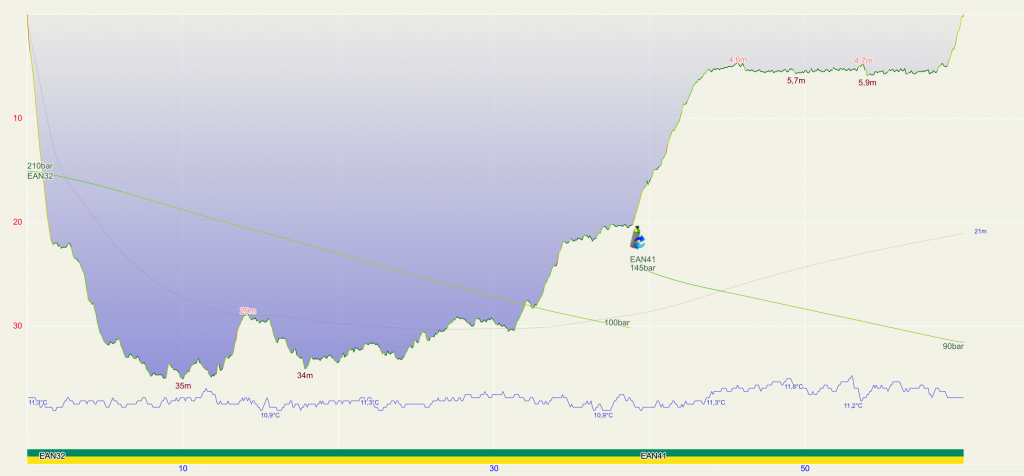
Source: http://www.scapaflowwrecks.com/wrecks/coln/index.php
Wikipedia: https://en.wikipedia.org/wiki/SMS_C%C3%B6ln_(1916)
- ATIONALITY: German
- LAUNCHED: 5 October 1916
- COMMISSIONED: 17 January 1918
- BUILDER: Blohm and Voss, Hamburg
- CONSTRUCTION NO: 247
- TYPE: Light Cruiser
- SUBTYPE/CLASS: Cöln Class
- DISPLACEMENT (STANDARD): 5,620 tonnes
- DISPLACEMENT (FULL LOAD): 7,486 tonnes
- LENGTH OVERALL: 115m *
- BEAM: 12m
- DRAUGHT: 6.01-6.43m
- COMPLEMENT: 559
- MATERIAL: Steel
- CAUSE LOST: Scuttled
- DATE LOST: 21 June 1919. 1350 hrs
- CASUALTIES: 0
- PROPULSION: Eight coal and six oil marine-type boilers, two sets of geared steam turbines, two propellers
- POWER: 48,708 shp** maximum
- SPEED: 29.3 Knots maximum
- ARMOUR: ranges from 20-60mm (position dependent), control tower 100mm (on the sides)
- ARMAMENT: 8 x 15 cm, 3 x 8.8 cm anti-aircraft guns (reduced to two in 1918), 4 x 60cm deck-mounted torpedo tubes , 200 mines
History
SMS Cöln was a Cöln class light cruiser and one of only two ships of this class to be completed. The other was sister ship SMS Dresden, which also lies on the seabed of Scapa Flow today.
SMS Cöln was named after her predecessor, which sank near Heligoland in the south-east North Sea. She was built in Hamburg and was launched on 5 October 1916.
Only SMS Cöln and SMS Dresden of this class were completed during the war. A class of ten ships had been planned – two being completed, five scrapped after launching, and three scrapped on the stocks.
SMS Cöln and SMS Dresden were the final class of light cruisers to be built during World War I and demonstrated Germany’s continued interest in building surface warships, even after failing to achieve a breakout during the Battle of Jutland in 1916.
For many years there has been confusion surrounding the spelling of Cöln. Köln is the German name for the town of Cologne, but this spelling has varied over many years. The correct spelling for the ship is, indeed, Cöln and this can be seen on the ship’s bell, now on display at the Scapa Flow Visitor Centre and Museum at Lyness on Hoy.
Due to a lack of material and personnel, SMSCöln was not commissioned until 17 January 1918. Priority in manning was being given to the Submarine service at the time. The cruiser was eventually assigned to the II Scouting Group, which was made up of modern cruisers and comprised eight light cruisers at its largest.
The II Scouting Group was positioned at the head of the line in all fleet advances and during attacks on the British coast. As a result the Group suffered badly during the Battle of Jutland in 1916, before SMS Cöln had been commissioned.
But for SMS Cöln there was little action except for mining and patrolling in the German Bight. At the war’s end, she was in Wilhelmshaven.
In the Kiel sailor mutiny of October 1918, her crew remained loyal, and put to sea to escape the unrest.
On 21 November 1918 SMS Cöln arrived in the Firth of Forth for inspection and then continued north to for internment in Scapa Flow. She reached Scapa Flow with some difficulty due to a leaking condenser.
Mijn duiken:

Gelukkig zijn er op dit wrak nog wel veel herkenbare delen te vinden in tegenstelling tot andere wrakken. Nadat we via de shotline naar beneden zijn gegaan, zijn we naar ongeveer het midden van het dek gegaan en vervolgens weer terug. Brug en Armoured control duidelijk waar kunnen nemen.


























